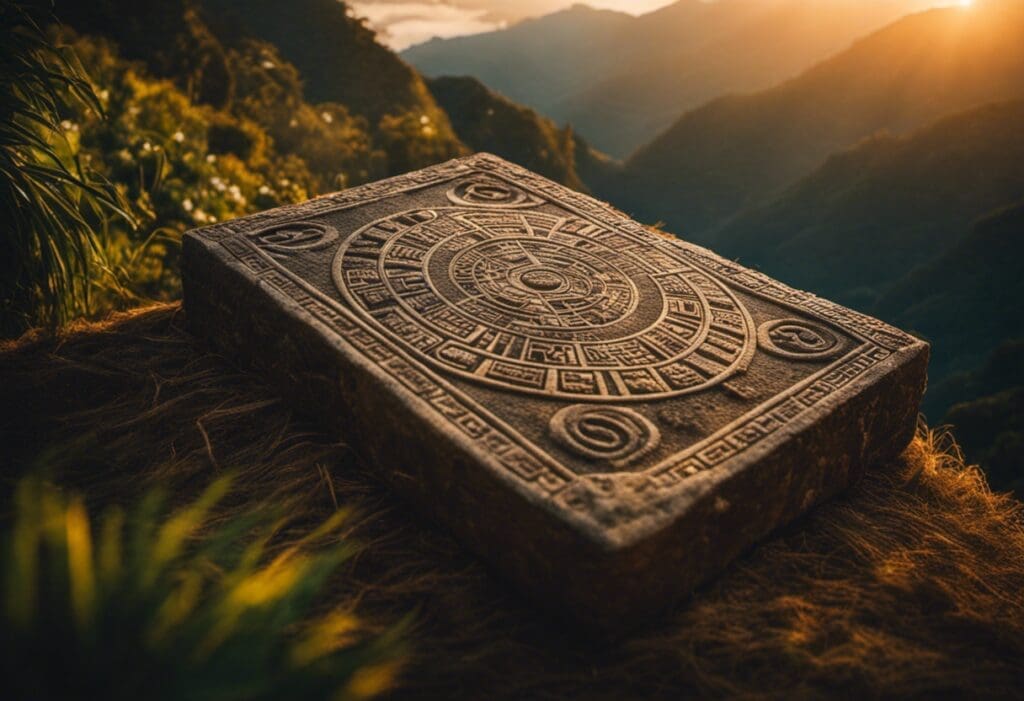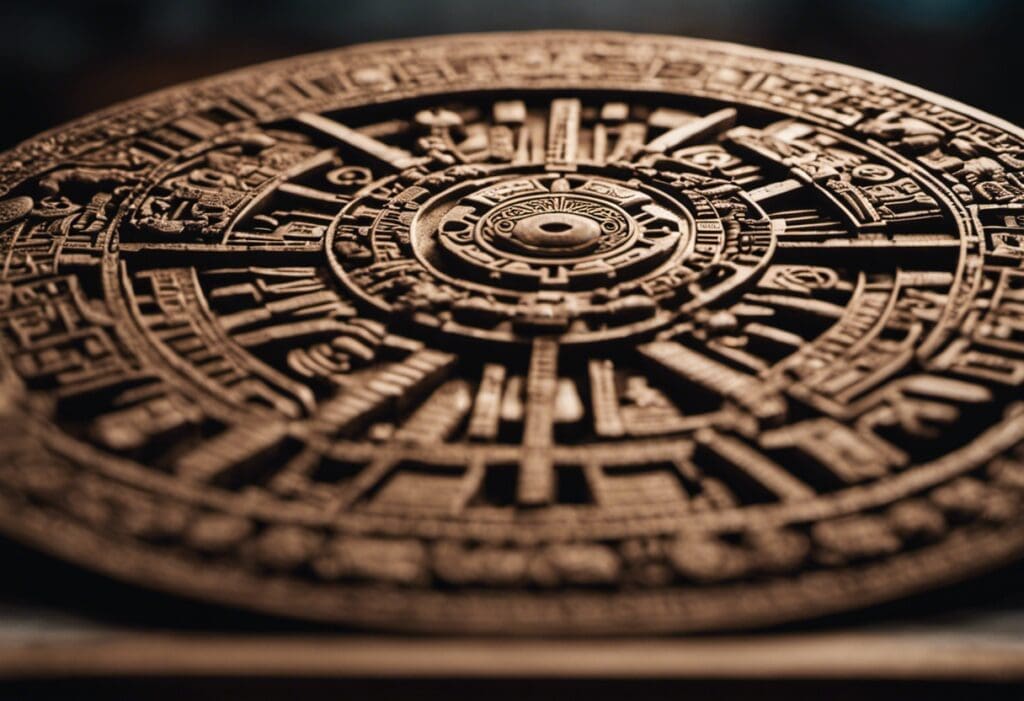In the depths of the Andes, an ancient civilization forged a calendar that rivaled any of its time.
As we delve into the enigmatic world of the Inca calendar, we embark on a journey of unraveling its secrets and understanding its profound significance.
Through rigorous analysis and a meticulous examination of its symbols and astronomical foundations, this article aims to shed light on the intricate timekeeping system of the Incas, offering a glimpse into their rich cultural heritage.
Key Takeaways
- The Inca calendar, known as the Tawantinsuyu calendar, originated from pre-Inca cultures in the Andean region of South America.
- The calendar was based on astronomical observations and allowed the Inca people to track time and align their religious ceremonies and agricultural activities.
- Decoding the symbols of the Inca calendar, known as the Quipu, requires a deep understanding of Inca culture and their worldview.
- Astronomy played a significant role in the Inca calendar system, with celestial events serving as markers for important agricultural, religious, and ceremonial activities.
The Origins of the Inca Calendar


What are the origins of the Inca calendar and how did it come to be?
The Inca calendar, known as the Tawantinsuyu calendar, was a vital component of the Inca civilization’s socio-religious system. Its origins can be traced back to the pre-Inca cultures that inhabited the Andean region of South America. The Inca Empire, which reached its height in the 15th century, further developed and refined this calendar system.
The Inca calendar was based on astronomical observations and the complex understanding of celestial bodies. It revolved around the movement of the Sun, Moon, and stars, allowing the Inca people to track the passage of time and align their religious ceremonies and agricultural activities with the natural cycles. The calendar was crucial for planning agricultural activities, predicting weather patterns, and organizing religious festivals.
The development of the Inca calendar was a result of the Inca civilization’s deep connection with nature and their keen observation of the celestial phenomena. It showcased their advanced understanding of astronomy and their ability to create a sophisticated calendar system that served both practical and spiritual purposes.
Decoding the Inca Calendar Symbols


The process of deciphering the intricate symbols within the Inca calendar involves a meticulous examination of their meanings and the contextual relationships between them. The Inca calendar, known as the Quipu, is a system of knotted cords and colorful threads that served as a means of recording and conveying information.
Each symbol within the calendar represents a specific concept or event, such as agricultural activities, astronomical phenomena, or religious rituals. Decoding these symbols requires a deep understanding of Inca culture and their worldview. Scholars have studied surviving Quipus, as well as historical accounts and artifacts, to piece together the meaning behind the symbols.
For example, a symbol depicting a corn stalk may represent the planting season, while a symbol of a llama may signify an important religious ceremony. The Inca calendar symbols often incorporate multiple layers of meaning and are interconnected. Patterns and repetitions within the symbols can provide clues about their significance and their relationship to other symbols.
The Role of Astronomy in the Inca Calendar


How did astronomy play a significant role in the Inca calendar system?
Astronomy was deeply integrated into the Inca calendar, as the Inca civilization placed great importance on celestial events and their connection to the spiritual world. The Inca calendar, known as the Tawantinsuyu, was based on the movements of the sun, moon, and stars, which were observed and recorded by Inca astronomers. These celestial events served as markers for important agricultural, religious, and ceremonial activities for the Inca people.
The Inca used their knowledge of astronomy to determine the optimal times for planting and harvesting crops, as well as for organizing religious rituals and ceremonies. They believed that the alignment of celestial bodies influenced the success or failure of their agricultural endeavors, and that by understanding these patterns, they could ensure the prosperity of their empire.
One of the most significant celestial events observed by the Inca was the winter solstice, known as Inti Raymi. This event marked the beginning of the agricultural year and was celebrated with elaborate ceremonies and offerings to the sun god, Inti. The Inca also paid close attention to lunar cycles and used them to determine the timing of religious festivals and rituals.
Understanding the Inca Calendar’s Timekeeping System


The Inca calendar’s timekeeping system relied on intricate astronomical observations and precise mathematical calculations. This system allowed the Inca civilization to track time, predict celestial events, and organize their religious and agricultural activities. Understanding the Inca calendar’s timekeeping system is crucial for interpreting its significance and the rituals associated with it.
Some key features of the Inca calendar’s timekeeping system include:
- Solar Year: The Inca calendar was primarily based on the solar year, which they estimated to be around 365.25 days. This allowed them to synchronize their agricultural practices with the seasons.
- Lunar Month: The Inca calendar also incorporated lunar months, which were approximately 29.5 days long. These lunar cycles helped in determining the timing of religious ceremonies and rituals.
Understanding the Inca calendar’s timekeeping system provides insights into their interpretation of time and their cultural practices. It allows us to appreciate the precision and knowledge of the Inca civilization and how they used the calendar to regulate their daily lives, religious ceremonies, agricultural activities, and other important events.
The Cultural Significance of the Inca Calendar


Rituals and cultural practices surrounding the Inca calendar played a crucial role in shaping the beliefs, traditions, and social structure of the Inca civilization. The Inca calendar held great spiritual significance for the Inca people. It was believed to be a divine creation that allowed them to connect with the spiritual realm and communicate with their gods. The calendar was used to determine auspicious dates for important ceremonies and rituals, such as agricultural festivals, religious ceremonies, and the coronation of new rulers. These rituals were essential for maintaining harmony with the gods and ensuring the well-being of the community.
Moreover, the Inca calendar had significant agricultural implications. The Inca people were highly dependent on agriculture for their survival, and the calendar played a crucial role in guiding their agricultural practices. They used the calendar to determine the optimal time for planting, harvesting, and performing other agricultural activities. By aligning their agricultural practices with the cycles of the calendar, the Inca people were able to maximize their agricultural productivity and ensure food security for their population.
Conclusion
In conclusion, the Inca calendar remains a fascinating and complex system that reflects the rich cultural and astronomical knowledge of the Inca civilization. By decoding its symbols and understanding its timekeeping system, we can gain insights into the Inca’s understanding of time and their connection to the celestial world.
One interesting statistic is that the Inca calendar had 12 months, each consisting of 30 days, resulting in a total of 360 days in a year, which closely aligns with the solar year.




